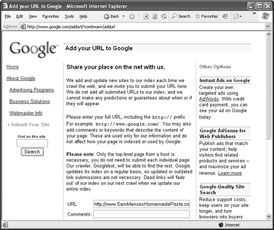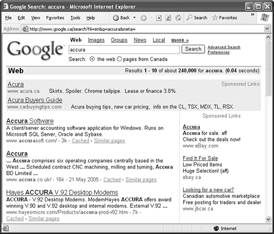Attract Visitors to Your Site: The Mini Missing Manual (4 page)
Read Attract Visitors to Your Site: The Mini Missing Manual Online
Authors: Matthew MacDonald

The Yahoo directory
ODP is a great starting point, but it isn’t the only directory on the block. The other heavyweight is the Yahoo directory (
http://dir.
yahoo.com/
). Unfortunately, getting your site into the Yahoo directory takes considerably more work.
First, there’s the issue of cost. If you’ve created a non-commercial site, you can probably get in free, but it may take persistence, emails, multiple submissions, and a bit of luck. If you’ve created a commercial site (one whose primary purpose is to make money) and you want to register it in the U.S. Yahoo directory, you need to pay an annual fee of several hundred dollars. And in the ultimate case of adding insult to injury, you won’t get your money back if Yahoo rejects your site.
To get started, you can review Yahoo’s official submission guidelines at
http://help.yahoo.com/l/us/yahoo/directory/suggest/listings-03.html/
. However, you’ll be much happier with the
unofficial
write-up at
http://www.apromotionguide.com/yahoo.html/
, which discusses your free and for-fee options, and explains what the cryptic rejection emails Yahoo sends out really mean. And if you have a commercial website, or you just don’t want to suffer through the slow and unreliable free registration process, you’ll need to use the Yahoo Directory Submit service (formerly called Yahoo Express), which is described at
https://ecom.yahoo.com/dir/submit/intro/
.
Once you’re done with directories (or just ready to move on), it’s time to take a look at full-text search engines.
Search Engines
For most people, search engines are the one and only tool for finding information on the Web. If you want the average person to find your site, you need to make sure it’s in the most popular search engine catalogs, and turns up as one of the results in relevant searches. This task is harder than it seems, because the Web is full of millions of sites jockeying for position. To get noticed, you need to spend time developing your site and enhancing its visibility. You also need to understand how search engines rank pages (see the box below for an example).
The undisputed king of Web search engines is Google (
http://www.google.com/
). Not only is it far and away the Web’s most popular search engine, it also powers other search engines (usually without being credited). Google performs an amazing amount of work—every day it chews through hundreds of millions of search requests.
Tip: For more information about search engines, including who’s on top and who owns who, check out
http://www.searchengineland.com/
.
It’s not too difficult to get Google to notice your site. By the time your site’s about a month old, Google will probably have stumbled across it at least once, usually by following a link from another site or from the ODP. As described in the box above, Google takes outside links into consideration when sizing up a site, so the more sites that link to you, the more likely you are to turn up in someone’s search results.
If you’re impatient or you think Google’s passing you by, you can introduce yourself directly using the submission form at
http://www.google.com/addurl/
(see
Figure 1-7
). Most popular search engines include a submission form like this. Just make sure you keep track of where you’ve submitted, so you don’t inadvertently submit your site to the same search engine more than once.
Rising up in the rankings
You’ll soon discover that it’s not difficult to get into Google’s index. But you might find it exceedingly hard to get noticed. For example, suppose you’ve submitted the site
http://www.SamMenzesHomemadePasta.com/.
To see if you’re in Google, try an extremely specific search that targets just your site, like “Sam Menzes Homemade Pasta.” This should definitely lead to your doorstep. Now, try searching for just “Homemade Pasta.” Odds are, you won’t turn up in the top 10, or even the top 100.
So how do you create a site that the casual searcher’s likely to find? There’s no easy answer. Just remember that the secret to getting a good search ranking is having a good PageRank, and getting a good PageRank is all about connections. To stand out, your website needs to share links with other leading sites in your category.
If you want to delve into the nitty-gritty of
search engine optimization
(known to webmasters as SEO), consider becoming a regular reader of
http://www.webmasterworld.com/
and
http://www.searchengineland.com/
. You’ll find articles and forums where webmasters discuss the good, bad, and downright seedy tricks you can try to get noticed.
Tip: It’s possible to get too obsessed with search engine rankings. Here’s a good rule of thumb—don’t spend more time trying to improve your search engine ranking than you do improving your website. In the long term, the only way to gain real popularity is to become one of the best sites on the block.
UP TO SPEED
How Google’s PageRank Works
Google uses a rating system called
PageRank
to size up different Web pages. Google doesn’t use PageRank to
find
search results; instead, it uses it to
order
them. When you execute a search with Google, it pulls out all the sites that match your search keywords. Then it orders the results according to the PageRank of each page.
The basic idea behind the PageRank system is that the value of your website is determined by the community of other websites that link to it. There are a few golden rules:
- The more sites that link to you, the better.
- A link from a more popular site (a site with a high PageRank) is more valuable than a link from a less popular site.
- The more links a site has, the less each link is worth. In other words, if someone links to your site and just a handful of other sites, that link is valuable. If someone links to your site and
hundreds
of other sites, the link’s value is diluted.
Although Google regularly fine-tunes its secret PageRank recipe, Web experts spend hours trying to deconstruct it. For some fascinating reading, you can learn more about how PageRank works (loosely) at
http://www.akamarketing.com/google-ranking-tips.html/
and
http://www.markhorrell.com/seo/pagerank.html/
. Google co-founders Sergey Brin and Larry Page describe the original formulation of PageRank in an academic paper by at
http://infolab.stanford.edu/~backrub/google.html/
.
For way more information about Google and its internal workings, check out
Google: The Missing Manual
.
The Google Webmaster Tools
If you’re feeling a bit in the dark about how your website rates with Google, you’ll be happy to know that Google has a service that can help you out. It’s called the Google Webmaster Tools, and you can sign up your site for free at
http://www.google.com/webmasters/tools/
.
Note: Before you can actually use the Google Webmaster Tools, you need to prove you own the site. To do this, Google asks you to upload a small file (a task that only a site owner can perform). Once Google finishes verifying your site, you can remove this file.
The Google Webmaster Tools let you look at your website through the eyes of Google. It divides its features into several sections. When you sign up, here’s what you see:
- Overview.
This section tells you whether Google has visited your site, and whether it’s successfully added your site to its index. You’ll also find links to Help documents that explain how Google sizes up a website and how you can climb the rankings. - Diagnostics.
This section warns you about any problems Google has encountered, like incorrect metadata (
“Adding Meta Elements”
) or pages that it couldn’t access (and therefore couldn’t index). - Statistics.
This section provides information about the searches that lead Googlers from the search engine to your website. For example, you might find out that people reach your pet food site after searching for “san francisco doggie treats.” You can get even more detailed statistics using the Google Analytics tracking service described in
“Tracking Visitors”
. - Links.
This section is most notable for its external link viewer, which shows you what websites link to yours. It’s like a super-powered version of the
link
: search operator that you learned about in
“Web Rings”
above. - Sitemaps.
This section helps you build a
sitemap
—a special file that describes the structure of your site and the files in it. You can submit your sitemap to Google and other search engines so they know what to index. This is particularly useful if you have pages that Google might ordinarily miss, like standalone pages (those not linked to other pages). - Tools.
This section lets you tweak a few miscellaneous Google settings (for example, how often it examines your site for new content). It also lets you create and analyze
robots.txt
files, which you can use to hide a portion of your site from nosy search engines, as explained in
“Hiding from search engines”
.
Most serious web designers eventually check out their websites with the Google Webmaster Tools. If nothing else, you can use it to make sure everything is running smoothly—in other words, that Google can access your site, that its automated search robots return frequently to check for new content, and that the robots review all the pages you have to offer.
Google AdWords
As a web-head, you’ve no doubt seen several lifetimes’ worth of flashing messages, gaudy banners, and invasive pop-ups, all trying to sell you some hideously awful products. It probably comes as no surprise to learn that these types of ads aren’t the way to promote your site—in fact, they’re more likely to alienate people than entice them. However, there are respectable paid placements that can get your site in front of the right readers, at the right time, and with the right amount of tact. One of the best is AdWords (
http://adwords.google.com/
), Google’s insanely flexible advertising system.
The idea behind AdWords is that you create text ads that Google shows alongside its regular search results (see
Figure 1-8
). The neat part is that Google doesn’t show the ads indiscriminately. Instead, you choose the search keywords you want your ad associated with.
The nice (and slightly confusing) part about AdWords is that you
bid
for the keywords you want to use. For example, you might tell Google you’re willing to pay 25 cents for the keyword “food.” Google takes this into consideration with everyone else’s bids, and displays the higher bidders’ ads more often. But Google isn’t out to rip anyone off, and it charges you only the going rate for your keyword, regardless of how much you told Google you’re willing to pay. And Google doesn’t charge you anything to simply display your ad on a search results page. It charges you only when someone clicks on your ad to get to your site.


